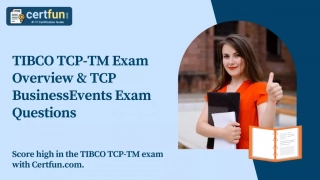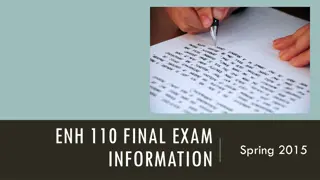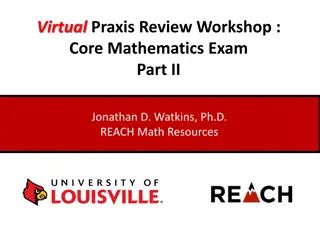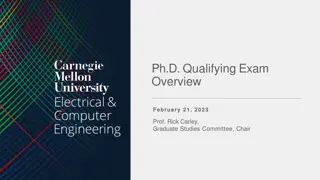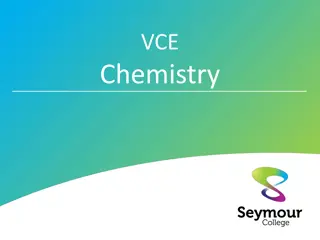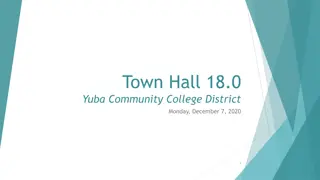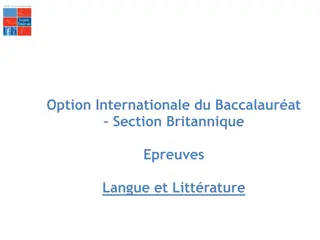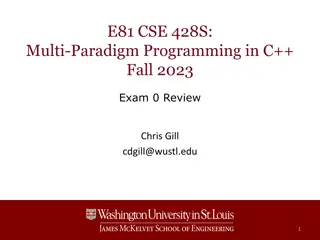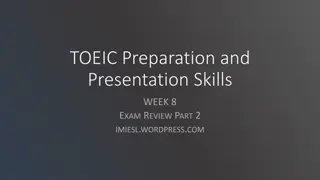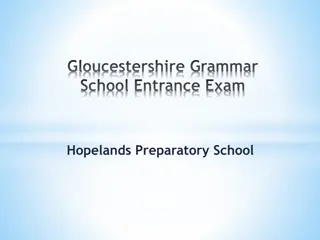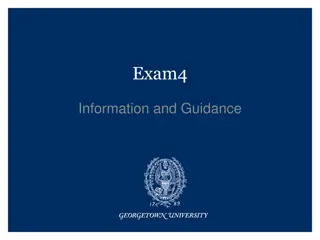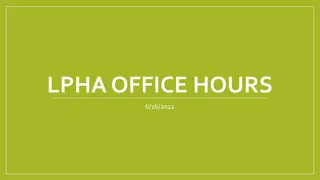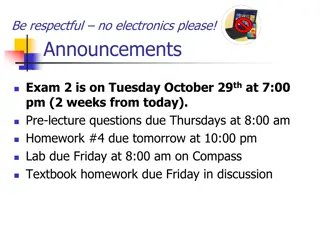Important Updates and Exam Information for Chemistry Class
Upcoming announcements include details about the first exam on September 24th at 7:00 pm, with additional sessions available for conflicting schedules. Various assignments deadlines and review questions are highlighted, along with a reminder about respectful behavior and a chemistry-themed joke. The exam topics cover major and minor concepts, along with the exam format specifying the structure and grading criteria. Students are encouraged to apply metacognition and reasoning when approaching problems and are given key tools and principles to aid in their preparation.
Uploaded on Sep 08, 2024 | 0 Views
Download Presentation

Please find below an Image/Link to download the presentation.
The content on the website is provided AS IS for your information and personal use only. It may not be sold, licensed, or shared on other websites without obtaining consent from the author.If you encounter any issues during the download, it is possible that the publisher has removed the file from their server.
You are allowed to download the files provided on this website for personal or commercial use, subject to the condition that they are used lawfully. All files are the property of their respective owners.
The content on the website is provided AS IS for your information and personal use only. It may not be sold, licensed, or shared on other websites without obtaining consent from the author.
E N D
Presentation Transcript
Be respectful no electronics please! Announcements Exam 1 Tuesday February September 24th, 7:00 pm Ice cream for highest averaging section Pre & Post-lecture Assignments (Lon-Capa) 8 am next Thursday Lab write-up 2 due tomorrow at 8 am in Compass Textbook homework Assignment 4 due tomorrow in discussion (pg. 16) Review Questions Part 1 Due Friday at 10:00 pm in Lon-Capa (will work on during discussion)
Joke of the Day What kind of dog do chemists have? Laboratory retrievers!
Be respectful no electronics please! Exam Info September 24th Conflict exam: Same day 5-6:30 pm in Noyes 217 Sign up in 1026 Chem Annex by noon on 9/24 Please email me if you have a conflict with both the regular exam and the conflict exam. Practice Exams posted online! My Question & Answer Session this weekend: Sunday 4-5 pm in 152 Chem Annex You may use a calculator (NOT TI-Nspire.)
Exam 1 Topics Major Topics Matter Naming Memorize polyatomics, especially those ending in -ate , hydroxide, ammonium The mole Empirical & molecular formula Gases & related problems Minor Topics Isotopes & ions (protons, neutrons, electrons) Conversion problems Density Chemical & physical changes Not Tested Significant Figures
Exam Format 90 minutes total 2 Free Response Questions 15 Multiple Choice Questions 5 possible choices 50% of test grade ~3 minutes to answer each Write in answers both qualitative and quantitative 50% of test grade ***A periodic table & cover sheet with equations will be attached.***
Metacognition & Reasoning 1. Can I visualize what s happening? 2. What are the principles and tools I can use to solve this? 3. Why can I use these? 4. Is the answer reasonable?
Some Tools & Principles 1 mole molar mass g 6.022 1023 1 mole particles (atoms or molecules) grams moles 1 mole 6.022 1023 molar mass g 1 mole PV=nRT (Solve for n) Use PV=nRT Gas properties Other tools: Dalton s Law of Partial Pressures Empirical & Molecular Formula Naming
Clicker#1 A closed tank consists of a mixture of 4.00 grams of helium and 160. grams of an unknown monatomic gas. The partial pressure of the unknown gas is four times the partial pressure of helium. Identify the gas. a) Kr b) Tb c) Ar d) Br e) F
Practice Question #2 Problem #118 Part a A 2.50-L flexible balloon at 1.00 atm and -48 C is filled with 2.71 g of a monatomic gas. Determine the identity of the gas.
Clicker #2 Problem #118 Part b Determine what will happen when 10.0 g of oxygen gas is added to the balloon. Compare the balloon before the gas has been added to after the gas has been added. *Note: the balloon is a flexible container. Variables that have changed Variables that are constant a) P, V, n T b) V, n T, P c) P, n V, n d) V, T P, n
Clicker #3 Problem #118 Part b Compare the volume of the balloon before the 10.0 g of oxygen gas has been added to the volume after the gas has been added. The volume of the balloon is the same. The volume of the balloon is larger than it was before but less than twice the size. The volume of the balloon is twice as large as it was before. The volume of the balloon is more than twice as large as it was before. a) b) c) d)
Clicker #4: Naming and Moles Which has the greatest number of ions if equal mole samples of each are dissolved in water? Iron(III) nitrate Sodium fluoride Potassium phosphate Magnesium acetate At least two of the above have the same greatest number of ions. a) b) c) d) e)
Clicker #5: Ions & Isotopes A certain ion has 27 electrons and 34 neutrons. Which of the following correctly identifies both the ion and its mass number? a) b) c) d) e) Ion Cu2+ Cu2+ Co2+ Co2+ Se2 Mass Number 63 61 61 59 61
Problem #6: Gases You are holding two balloons of the same volume. One balloon contains 1.0 g of helium. The other balloon contains neon. Calculate the mass of neon in the balloon.
Clicker #7: Percent Composition & Naming Which has the greatest number of sodium atoms if equal mass samples of each are dissolved in water? Sodium carbonate Sodium chloride a) b)


